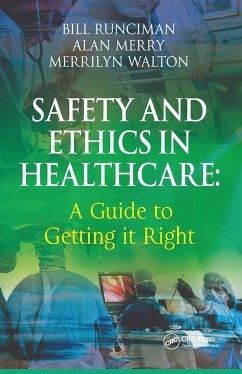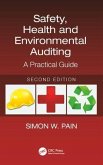Bill Runciman, Alan Merry, Merrilyn Walton
Safety and Ethics in Healthcare
A Guide to Getting it Right
Bill Runciman, Alan Merry, Merrilyn Walton
Safety and Ethics in Healthcare
A Guide to Getting it Right
- Gebundenes Buch
- Merkliste
- Auf die Merkliste
- Bewerten Bewerten
- Teilen
- Produkt teilen
- Produkterinnerung
- Produkterinnerung
A single coherent source of information on the various interlinking domains of patient safety, litigation and ethical behaviour, based on accounts of real-life situations and intended for all healthcare students, specialists and administrators.
Andere Kunden interessierten sich auch für
![Critical Interventions in the Ethics of Healthcare Critical Interventions in the Ethics of Healthcare]() Dave HolmesCritical Interventions in the Ethics of Healthcare206,99 €
Dave HolmesCritical Interventions in the Ethics of Healthcare206,99 €![Crew Resource Management Training Crew Resource Management Training]() Norman MacleodCrew Resource Management Training176,99 €
Norman MacleodCrew Resource Management Training176,99 €![Misadventures in Health Care Misadventures in Health Care]() Marilyn Sue BognerMisadventures in Health Care147,99 €
Marilyn Sue BognerMisadventures in Health Care147,99 €![Management and Supervisory Practices for Environmental Professionals Management and Supervisory Practices for Environmental Professionals]() Herman KorenManagement and Supervisory Practices for Environmental Professionals174,99 €
Herman KorenManagement and Supervisory Practices for Environmental Professionals174,99 €![Safety, Health and Environmental Auditing Safety, Health and Environmental Auditing]() Simon Watson PainSafety, Health and Environmental Auditing174,99 €
Simon Watson PainSafety, Health and Environmental Auditing174,99 €![Occupational Diseases in the Construction Industry Occupational Diseases in the Construction Industry]() Imriyas KamardeenOccupational Diseases in the Construction Industry211,99 €
Imriyas KamardeenOccupational Diseases in the Construction Industry211,99 €![A Definitive Guide to Behavioural Safety A Definitive Guide to Behavioural Safety]() Tim MarshA Definitive Guide to Behavioural Safety176,99 €
Tim MarshA Definitive Guide to Behavioural Safety176,99 €-
-
-
A single coherent source of information on the various interlinking domains of patient safety, litigation and ethical behaviour, based on accounts of real-life situations and intended for all healthcare students, specialists and administrators.
Hinweis: Dieser Artikel kann nur an eine deutsche Lieferadresse ausgeliefert werden.
Hinweis: Dieser Artikel kann nur an eine deutsche Lieferadresse ausgeliefert werden.
Produktdetails
- Produktdetails
- Verlag: Taylor & Francis Ltd (Sales)
- Seitenzahl: 360
- Erscheinungstermin: 19. Februar 2007
- Englisch
- Abmessung: 234mm x 156mm x 21mm
- Gewicht: 680g
- ISBN-13: 9780754644354
- ISBN-10: 0754644359
- Artikelnr.: 45101618
- Herstellerkennzeichnung
- Libri GmbH
- Europaallee 1
- 36244 Bad Hersfeld
- gpsr@libri.de
- Verlag: Taylor & Francis Ltd (Sales)
- Seitenzahl: 360
- Erscheinungstermin: 19. Februar 2007
- Englisch
- Abmessung: 234mm x 156mm x 21mm
- Gewicht: 680g
- ISBN-13: 9780754644354
- ISBN-10: 0754644359
- Artikelnr.: 45101618
- Herstellerkennzeichnung
- Libri GmbH
- Europaallee 1
- 36244 Bad Hersfeld
- gpsr@libri.de
Bill Runciman is Professor of Anaesthesia and Intensive Care at the Adelaide University and Head of the Department of Anaesthesia and Intensive Care at the Royal Adelaide Hospital. He founded the Australian Patient Safety Foundation in 1988, and is the current President. He has been a member of task forces which produced world patient safety standards for both Anaesthesia and Intensive Care. He was Chairman of the Safety and Quality of Practice Committee of the World Federation of Societies of Anaesthesiologists from 1992 to 2000. He has been a member of the Australian Council for Safety and Quality in Healthcare and of the Australian Health Information Council, and is joint co-ordinator of groups developing research tools and an International Patient Safety Classification for the World Alliance for Patient Safety of the World Health Organization. Alan Merry is Professor of Anaesthesiology at the University of Auckland. He chairs the Quality and Safety Committee of the World Federation of Societies of Anaesthesiologists. He is a Councillor of the Australian and New Zealand College of Anaesthetists, chairs the College's Quality and Safety Committee, and has chaired its New Zealand National Committee. He co-chaired the New Zealand Medical Law Reform Group and has been president of the Auckland Medico-Legal Society. He is co-author of the books Errors, Medicine and the Law (with Alexander McCall Smith; Cambridge University Press, 2001) and Essential Perioperative Transoesophageal Echocardiography (with David Sidebotham and Malcolm Legget; Butterworth-Heinemann, 2003). Merrilyn Walton is an Associate Professor in the Faculty of Medicine at the University of Sydney. She chairs the Personal and Professional Development Theme and teaches students and clinicians about ethical practice, quality and safety. Her interests include enhancing the training environment for medical students and doctors and advocating for patients to be fully engaged in health care at every level. She was the founding Commissioner for the NSW Health Care Complaints Commission (1993-2000), and is a board member of the NSW Institute for Medical Education and Training and chairs its Prevocational Training Council.
Contents: Foreword
Preface. Part 1 What is Wrong with Healthcare: Setting the stage: an overview of healthcare
Risk and the harm caused by healthcare
Healthcare: a dysfunctional system
Naming, blaming and shaming. Part 2 Understanding the Basics: Human error and complex systems
Knowing what to do
Ethics, professional behaviour and regulation. Part 3 What to Do When Things Go Wrong: When things go wrong: looking after the people involved
When things go wrong: preventing a recurrence. Part 4 Preventing Things from Going Wrong: Getting the best out of people
Getting the best out of the system
Where to now? Appendices: Preferred terms and definitions for key safety and quality concepts
Public expenditure on healthcare in selected countries
Risk matrix
Evidence-based medicine: sources of information
International code of medical ethics
Jonsen's ethics framework
Severity assessment code (SAC)
The advanced incident monitoring system (AIMS)
Soft systems methodology (SSM)
Sources of information for patients. Index.
Preface. Part 1 What is Wrong with Healthcare: Setting the stage: an overview of healthcare
Risk and the harm caused by healthcare
Healthcare: a dysfunctional system
Naming, blaming and shaming. Part 2 Understanding the Basics: Human error and complex systems
Knowing what to do
Ethics, professional behaviour and regulation. Part 3 What to Do When Things Go Wrong: When things go wrong: looking after the people involved
When things go wrong: preventing a recurrence. Part 4 Preventing Things from Going Wrong: Getting the best out of people
Getting the best out of the system
Where to now? Appendices: Preferred terms and definitions for key safety and quality concepts
Public expenditure on healthcare in selected countries
Risk matrix
Evidence-based medicine: sources of information
International code of medical ethics
Jonsen's ethics framework
Severity assessment code (SAC)
The advanced incident monitoring system (AIMS)
Soft systems methodology (SSM)
Sources of information for patients. Index.
Contents: Foreword
Preface. Part 1 What is Wrong with Healthcare: Setting the stage: an overview of healthcare
Risk and the harm caused by healthcare
Healthcare: a dysfunctional system
Naming, blaming and shaming. Part 2 Understanding the Basics: Human error and complex systems
Knowing what to do
Ethics, professional behaviour and regulation. Part 3 What to Do When Things Go Wrong: When things go wrong: looking after the people involved
When things go wrong: preventing a recurrence. Part 4 Preventing Things from Going Wrong: Getting the best out of people
Getting the best out of the system
Where to now? Appendices: Preferred terms and definitions for key safety and quality concepts
Public expenditure on healthcare in selected countries
Risk matrix
Evidence-based medicine: sources of information
International code of medical ethics
Jonsen's ethics framework
Severity assessment code (SAC)
The advanced incident monitoring system (AIMS)
Soft systems methodology (SSM)
Sources of information for patients. Index.
Preface. Part 1 What is Wrong with Healthcare: Setting the stage: an overview of healthcare
Risk and the harm caused by healthcare
Healthcare: a dysfunctional system
Naming, blaming and shaming. Part 2 Understanding the Basics: Human error and complex systems
Knowing what to do
Ethics, professional behaviour and regulation. Part 3 What to Do When Things Go Wrong: When things go wrong: looking after the people involved
When things go wrong: preventing a recurrence. Part 4 Preventing Things from Going Wrong: Getting the best out of people
Getting the best out of the system
Where to now? Appendices: Preferred terms and definitions for key safety and quality concepts
Public expenditure on healthcare in selected countries
Risk matrix
Evidence-based medicine: sources of information
International code of medical ethics
Jonsen's ethics framework
Severity assessment code (SAC)
The advanced incident monitoring system (AIMS)
Soft systems methodology (SSM)
Sources of information for patients. Index.








